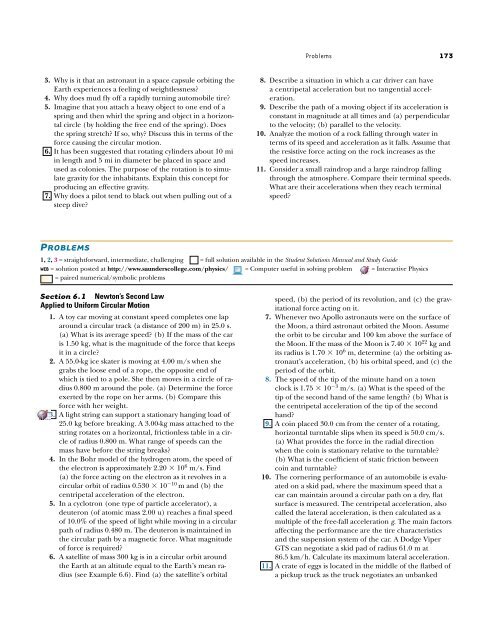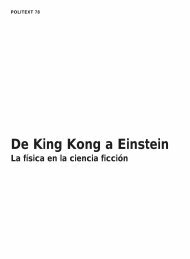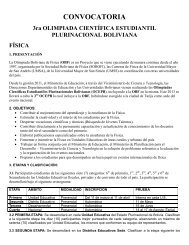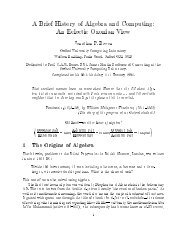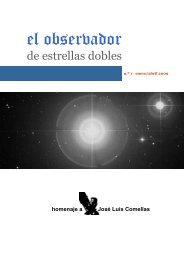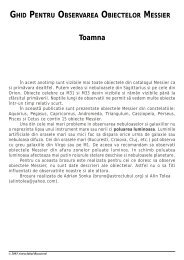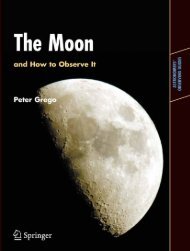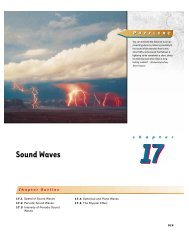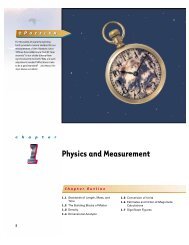Circular Motion and Other Applications of Newton's Laws
Circular Motion and Other Applications of Newton's Laws
Circular Motion and Other Applications of Newton's Laws
Create successful ePaper yourself
Turn your PDF publications into a flip-book with our unique Google optimized e-Paper software.
3. Why is it that an astronaut in a space capsule orbiting the<br />
Earth experiences a feeling <strong>of</strong> weightlessness?<br />
4. Why does mud fly <strong>of</strong>f a rapidly turning automobile tire?<br />
5. Imagine that you attach a heavy object to one end <strong>of</strong> a<br />
spring <strong>and</strong> then whirl the spring <strong>and</strong> object in a horizontal<br />
circle (by holding the free end <strong>of</strong> the spring). Does<br />
the spring stretch? If so, why? Discuss this in terms <strong>of</strong> the<br />
force causing the circular motion.<br />
6. It has been suggested that rotating cylinders about 10 mi<br />
in length <strong>and</strong> 5 mi in diameter be placed in space <strong>and</strong><br />
used as colonies. The purpose <strong>of</strong> the rotation is to simulate<br />
gravity for the inhabitants. Explain this concept for<br />
producing an effective gravity.<br />
7. Why does a pilot tend to black out when pulling out <strong>of</strong> a<br />
steep dive?<br />
PROBLEMS<br />
Section 6.1 Newton’s Second Law<br />
Applied to Uniform <strong>Circular</strong> <strong>Motion</strong><br />
1. A toy car moving at constant speed completes one lap<br />
around a circular track (a distance <strong>of</strong> 200 m) in 25.0 s.<br />
(a) What is its average speed? (b) If the mass <strong>of</strong> the car<br />
is 1.50 kg, what is the magnitude <strong>of</strong> the force that keeps<br />
it in a circle?<br />
2. A 55.0-kg ice skater is moving at 4.00 m/s when she<br />
grabs the loose end <strong>of</strong> a rope, the opposite end <strong>of</strong><br />
which is tied to a pole. She then moves in a circle <strong>of</strong> radius<br />
0.800 m around the pole. (a) Determine the force<br />
exerted by the rope on her arms. (b) Compare this<br />
force with her weight.<br />
3. A light string can support a stationary hanging load <strong>of</strong><br />
25.0 kg before breaking. A 3.00-kg mass attached to the<br />
string rotates on a horizontal, frictionless table in a circle<br />
<strong>of</strong> radius 0.800 m. What range <strong>of</strong> speeds can the<br />
mass have before the string breaks?<br />
4. In the Bohr model <strong>of</strong> the hydrogen atom, the speed <strong>of</strong><br />
the electron is approximately 2.20 � 106 m/s. Find<br />
(a) the force acting on the electron as it revolves in a<br />
circular orbit <strong>of</strong> radius 0.530 � 10�10 m <strong>and</strong> (b) the<br />
centripetal acceleration <strong>of</strong> the electron.<br />
5. In a cyclotron (one type <strong>of</strong> particle accelerator), a<br />
deuteron (<strong>of</strong> atomic mass 2.00 u) reaches a final speed<br />
<strong>of</strong> 10.0% <strong>of</strong> the speed <strong>of</strong> light while moving in a circular<br />
path <strong>of</strong> radius 0.480 m. The deuteron is maintained in<br />
the circular path by a magnetic force. What magnitude<br />
<strong>of</strong> force is required?<br />
6. A satellite <strong>of</strong> mass 300 kg is in a circular orbit around<br />
the Earth at an altitude equal to the Earth’s mean radius<br />
(see Example 6.6). Find (a) the satellite’s orbital<br />
Problems 173<br />
8. Describe a situation in which a car driver can have<br />
a centripetal acceleration but no tangential acceleration.<br />
9. Describe the path <strong>of</strong> a moving object if its acceleration is<br />
constant in magnitude at all times <strong>and</strong> (a) perpendicular<br />
to the velocity; (b) parallel to the velocity.<br />
10. Analyze the motion <strong>of</strong> a rock falling through water in<br />
terms <strong>of</strong> its speed <strong>and</strong> acceleration as it falls. Assume that<br />
the resistive force acting on the rock increases as the<br />
speed increases.<br />
11. Consider a small raindrop <strong>and</strong> a large raindrop falling<br />
through the atmosphere. Compare their terminal speeds.<br />
What are their accelerations when they reach terminal<br />
speed?<br />
1, 2, 3 = straightforward, intermediate, challenging = full solution available in the Student Solutions Manual <strong>and</strong> Study Guide<br />
WEB = solution posted at http://www.saunderscollege.com/physics/ = Computer useful in solving problem = Interactive Physics<br />
= paired numerical/symbolic problems<br />
speed, (b) the period <strong>of</strong> its revolution, <strong>and</strong> (c) the gravitational<br />
force acting on it.<br />
7. Whenever two Apollo astronauts were on the surface <strong>of</strong><br />
the Moon, a third astronaut orbited the Moon. Assume<br />
the orbit to be circular <strong>and</strong> 100 km above the surface <strong>of</strong><br />
the Moon. If the mass <strong>of</strong> the Moon is 7.40 � 10 22 kg <strong>and</strong><br />
its radius is 1.70 � 10 6 m, determine (a) the orbiting astronaut’s<br />
acceleration, (b) his orbital speed, <strong>and</strong> (c) the<br />
period <strong>of</strong> the orbit.<br />
8. The speed <strong>of</strong> the tip <strong>of</strong> the minute h<strong>and</strong> on a town<br />
clock is 1.75 � 10 �3 m/s. (a) What is the speed <strong>of</strong> the<br />
tip <strong>of</strong> the second h<strong>and</strong> <strong>of</strong> the same length? (b) What is<br />
the centripetal acceleration <strong>of</strong> the tip <strong>of</strong> the second<br />
h<strong>and</strong>?<br />
9. A coin placed 30.0 cm from the center <strong>of</strong> a rotating,<br />
horizontal turntable slips when its speed is 50.0 cm/s.<br />
(a) What provides the force in the radial direction<br />
when the coin is stationary relative to the turntable?<br />
(b) What is the coefficient <strong>of</strong> static friction between<br />
coin <strong>and</strong> turntable?<br />
10. The cornering performance <strong>of</strong> an automobile is evaluated<br />
on a skid pad, where the maximum speed that a<br />
car can maintain around a circular path on a dry, flat<br />
surface is measured. The centripetal acceleration, also<br />
called the lateral acceleration, is then calculated as a<br />
multiple <strong>of</strong> the free-fall acceleration g. The main factors<br />
affecting the performance are the tire characteristics<br />
<strong>and</strong> the suspension system <strong>of</strong> the car. A Dodge Viper<br />
GTS can negotiate a skid pad <strong>of</strong> radius 61.0 m at<br />
86.5 km/h. Calculate its maximum lateral acceleration.<br />
11. A crate <strong>of</strong> eggs is located in the middle <strong>of</strong> the flatbed <strong>of</strong><br />
a pickup truck as the truck negotiates an unbanked


